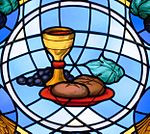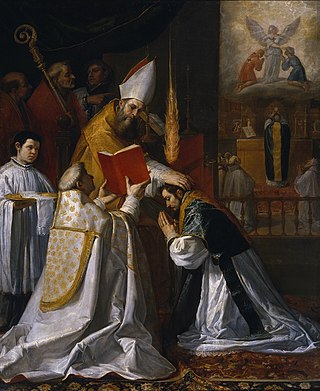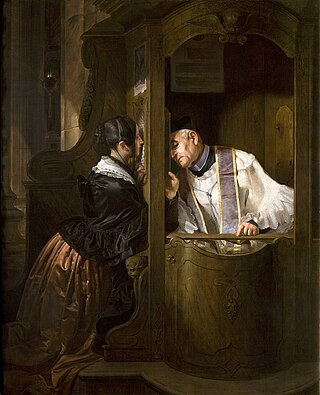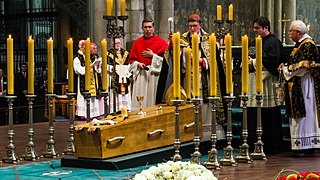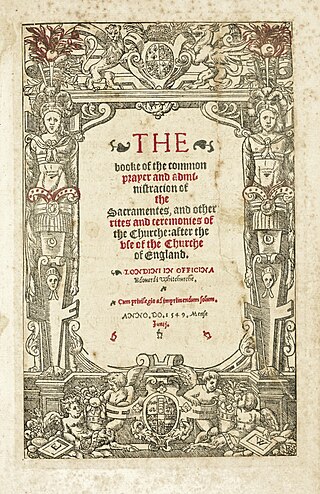In a prayer of entire consecration, a Christian surrenders himself/herself to God in order to allow Him to entirely sanctify his/her soul. [7] A believer offers to God "his time, his plans, his possessions, himself, his all" in consecration. [6] As such, consecration is "a pledge of an eternal 'yes' to all the will of God" in Wesleyan-Arminian theology. [7] With this human initiative of setting oneself apart for God, the believer is able to be entirely sanctified; the theology behind consecration is summarized with the maxim "Give yourself to God in all things, if you would have God give Himself to you." [7] United Methodist elder Craig Adams in discussing "the need for a particular moment of consecration and faith in a believer's life", referenced the theological tract On the Act or Covenant of Religious Consecration, authored by Thomas Cogswell Upham, which provides the following prayer of consecration composed by cleric Philip Doddridge as an example: [8] [9]
Eternal and ever blessed God! I desire to present myself before Thee with the deepest humiliation and abasement of soul, sensible how unworthy such a sinful worm is, to appear before the Holy Majesty of heaven, and to enter into a Covenant transaction with Thee. I come acknowledging myself to have been a great offender; smiting on my breast and saying with the humble publican, God be merciful to me a sinner. I come invited in the name of thy Son, and wholly trusting in his perfect righteousness; intreating that, for his sake, Thou wilt be merciful to my unrighteousness, and wilt no more remember my sins.
Permit me, O Lord, to bring back unto Thee those powers and faculties, which I have ungratefully and sacrilegiously alienated from thy service: And receive, I beseech Thee, thy poor revolted creature, who is now convinced of thy right to him, and desires nothing in the world so much as to be Thine. It is with the utmost solemnity, that I make this surrender of myself unto Thee. I avouch the Lord this day to be my God; and I avouch and declare myself this day to be one of his Covenant children and people. Hear, O Thou God of heaven, and record it in the book of thy remembrance, that I am thine, ENTIRELY THINE. I would not merely consecrate to Thee some of my powers, or some of my possessions, or give Thee a certain portion of my services, or all I am capable of for a limited time; [but I give myself to Thee and promise, relying upon thy divine assistance, ] to be wholly thine and thine forever.
From this day do I solemnly renounce all the former Lords, which have had dominion over me, every sin and every lust, and in thy name set myself in eternal opposition to the powers of Hell, which have most unjustly usurped the empire over my soul, and to all the corruptions, which their fatal temptations have introduced into it. The whole frame of my nature, all the faculties of my mind and all the members of my body would I present before Thee this day, as a living sacrifice HOLY and ACCEPTABLE to God, which I know to be my most reasonable service. [To thee I consecrate not only my person and powers,] but all my worldly possessions; and earnestly pray Thee also to give me strength and courage to exert for thy glory all the influence I may have over others in the relations of life, in which I stand.
Nor do I only consecrate all that I am and have to do thy service; but I also most humbly resign and submit myself and all that I can call mine, [to endure and suffer at thy hand whatsoever thou mayst see fit to impose upon me in the dispensations] of thy holy and sovereign will. I leave, O Lord, to thy management and direction all I possess and all I wish; and set every enjoyment and every interest before Thee, to be disposed of as thou pleasest; contentedly resolving, in all that thou appointest for me, my will into Thine, and looking on myself as NOTHING, and on Thee, O God, as the great, Eternal All, whose word ought to determine every thing; and whose government ought to be the joy of the whole rational creation.
Receive, O heavenly Father, thy returning prodigal! Wash me in the blood of thy dear Son! Clothe me with thy perfect righteousness; and sanctify me throughout by the power of thy Spirit. And O Lord, when thou seest the agonies of dissolving nature upon me, remember this Covenant, even though I should then be incapable of recollecting it, and look with pitying eye upon thy dying child. Put strength and confidence into my departing spirit; and receive it to the embraces of thine everlasting love. Amen. [9]
